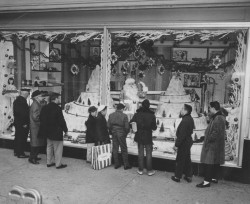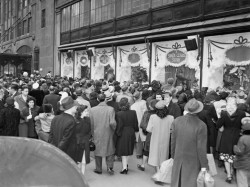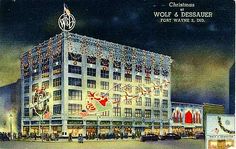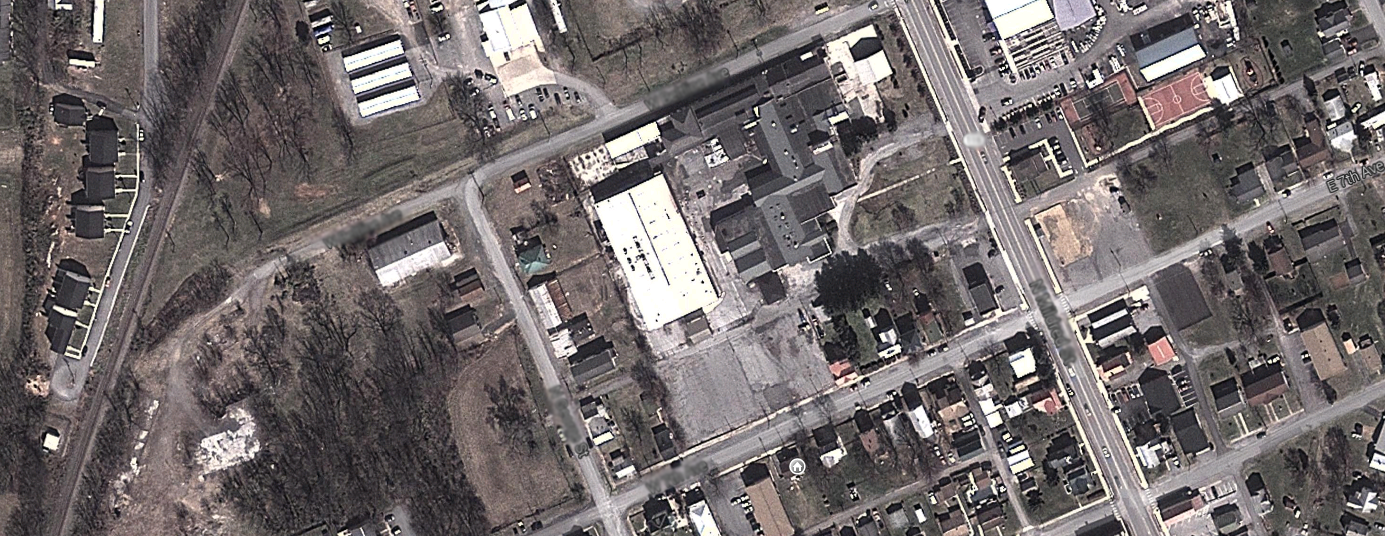Category Archives: Downtown
It began with Wolf and Dessauer. In the years before shopping malls and chain retail stores, Wolf and Dessauer was where Fort Wayne shopped. A purely local department store, it made its name as a place that was not just for shopping, but twas a social experience, with high levels of customer service, lounging rooms for tired shoppers, and access to telephones for people who who did not yet have one at home.
And Christmas was (so I hear; it was before my time) a magical time at W&D. They were famous for their magic windows, which some say were the equal of Macy’s.
In 1937 W&D hung a 25 foot wreath containing a reported 40,000 lights from the side of the building. Then in 1940 they constructed a 51 yard long display of Santa and his reindeer . Made of wood and containing (depending on which of the many unverified sources one believes) between 24,000 and 40,000 lights. It took workers several weeks to hang it, using blocks and tackles to haul the pieces manually up the side of the building.
 The display was only up for two years before WWII intervened, with demands for reductions in energy usage and night-time blackout requirements. (Fort Wayne was, and is, an important industrial city, and apparently officials were worried the Germans might sneak across the Atlantic and 700 miles of U.S. territory without being detected to bomb armament factories.) Shut down for three years, the display returned in 1945, a joyous symbol of the end of war.
The display was only up for two years before WWII intervened, with demands for reductions in energy usage and night-time blackout requirements. (Fort Wayne was, and is, an important industrial city, and apparently officials were worried the Germans might sneak across the Atlantic and 700 miles of U.S. territory without being detected to bomb armament factories.) Shut down for three years, the display returned in 1945, a joyous symbol of the end of war.
Santa and the wreath were displayed for 14 years, then put into storage when Wolf and Dessauer moved to a new building, and was not put up again the next Christmas.
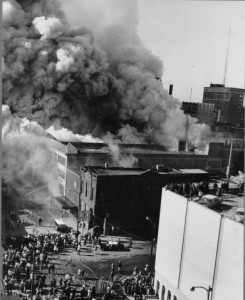 In 1962 the old building was destroyed in one of the largest fires in Fort Wayne history. As firefighters struggled against large crowds and freezing weather that froze the spray from their firehoses, five buildings were damaged or destroyed, and at least one fireman lost his life.
In 1962 the old building was destroyed in one of the largest fires in Fort Wayne history. As firefighters struggled against large crowds and freezing weather that froze the spray from their firehoses, five buildings were damaged or destroyed, and at least one fireman lost his life.
In 1966 Wolf and Dessauer sold their business to City Stores, a Delaware-based retail store holding company, and in 1969 City Stores sold W&D to Indianapolis-based department store chain L.S. Ayres. (See the subsequent history of Ayres below.*) L.S. Ayres had a store at the newly opened Glenbrook mall, then on the edge of the city, and in the early 1970s closed the downtown store.
My mother says she used to take my siblings and me to W&D to see the magic windows and sit on Santa’s lap every year before the store closed. Unfortunately I have only the very faintest memories of that, wholly without detail, and perhaps they’re really only memories of being told that we did that. And while my oldest brother and sister might have seen the Santa display as infants, it was already several years gone before I was born. But for older people, the Wolf and Dessauer Santa and wreath were among their most nostalgic memories.
For 20 years, longer than the original Santa had flown across the W&D store, and only a few years less than the wreath had hung there, the displays were lost. Or perhaps their location was known all along, but nobody was interested in reviving them. Or more likely, perhaps, the owners of W&D decided not to redisplay them after the move, and then as the company was sold and re-sold and old-timers of the company left the knowledge of the displays’ location was not passed on, and the new owners, managers actually, no longer locals but corporate types in distant cities, knew nothing of them and might not have cared if they did. They were running regional and national firms, not a local one.
Whatever the real story, in the spring of 1979 the displays were serendipitously discovered in a warehouse. That Christmas, two restored reindeer were displayed on the side of a downtown parking garage. In 1980, the whole display was lit for the first time since 1959, and has been displayed every year since. 2015 makes the 36th year of continuous display in its second incarnation, twice as long as its original display, and closing in on as many years as it was first displayed and then lost combined.
Today the historic Embassy Theater–a grand movie palace from the 1920s, now operated by a non-profit foundation–creates magic windows. Probably never again can we recapture the experience of a Wolf and Dessauer Christmas, but it’s still a wondrous experience to take my kids to see them. It’s a part of Fort Wayne that is special–beautiful, dazzling, historical, and evocative of the connections between past and present, all the more precious because they were once lost.

And today many of us have a bit of this history decorating our own homes at Christmas. In the mid 2,000s the tens of thousands of 11 watt bulbs were replaced with LEDs to save in energy costs (although three times the cost of the older bulbs, the LEDs were expected to pay for themselves in just two years). The old bulbs were given to charities to sell as Christmas ornaments. My Christmas gift from my mom that year was one of the old bulbs. It has hung on my Christmas tree every year since, and while my kids do the majority of the tree decorating (one of our annual gifts to them is an ornament each, and it’s great to watch them remember and reconnect with them each year), the bulb is one of the few ornaments I personally hang.
_____________________________
*Ayres was purchased by Associated Dry Goods of New York City in 1972, which then merged Ayres with the Cincinnati-based Pogues, keeping the Ayres name. In 1986 the May Department Store Company acquired Associated Dry Goods, and in 1987 Associated Dry Goods was renamed L.S. Ayres and Company. Ayres was then merged with St. Louis-based Famous-Barr (also owned by May) in 1991. In 2005, Federated Department Stores, which had previously purchased Macy’s, purchased the May company and merged Ayres into its Macy’s division, apparently ending the Ayres retail name.
Well, it’s finally happened. My daughter became a princess:
While we were down in Colosse, we visited my friend Kevin and his family, which includes two daughters and a son. While we talked the night away, they kind of swept Lain away and started playing dressup.
Which was pretty awesome. It was one of those things that provided the sort of experience that Boring Mom and Dad never give her. We don’t really do dresses, for the most part. We’ve had them, it just never occurs to me to actually put her in them. Even her Halloween costume consisted of a skeleton outfit.
But it was mostly awesome because Lain had some kids to play with and had an absolute blast. How Clancy and I ended up with a child that is so social is only slightly less a mystery than how we ended up with one who is shorter-than-average. It was really amazing to watch her play with other kids. The only downside is that we feel like we’re shortchanging her by not having more local friends with kids for her to play with. (Also short-changing ourselves, but that stings less.)
I had everything planned to get the laundry done on Sunday so that Clancy would start her week with a fresh batch of clothes to start from.
Things didn’t work out that way as the washer just upped and died. Well, it didn’t die. It went on strike is more likely, holding up a sign saying “I am not locked!” as it pickets the utility room. All of this being my clunky or clever way of saying that the problem seems to be relatively straightforward. It’s not properly locking, and without locking it won’t start a load.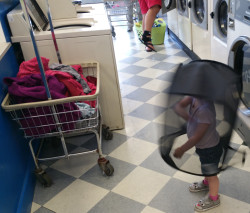 Which meant that I got to spend Labor Day at the laundry mat. I have been to the laundromat a couple of times for heavy blankets. The one I go to is on the sketchy side of town, mostly because it’s the one that came up when I initially googled it, and now I’m familiar with it.
Which meant that I got to spend Labor Day at the laundry mat. I have been to the laundromat a couple of times for heavy blankets. The one I go to is on the sketchy side of town, mostly because it’s the one that came up when I initially googled it, and now I’m familiar with it.
I had vaguely figured that the best time to go to the mat is in the morning. Most of the people most likely to use it don’t seem like the type to be early risers. This seems to be wrong, as each of three times it’s been busy when Ight the entire place was neat. For the most part. Her patience wore thin and for the second time she strung together the sentence “Want to go home.” Had it not been so busy, we would have been home by that point. She was a real trooper, given that it was hot and I was tyrannical about constantly telling her where she could not go.
Expecting that it would be as hot as it was, I actually wore shorts today and put Lain in the same. I almost never wear shorts. There’s a certain practicality to it when it’s 90 degrees out.
There was a guy there who (objectively!) thought Lain was beautiful and was very friendly to me throughout. He let me know when a device opened up. While we were outside, he came out to smoke a cigarette and we talked. Nice guy but… I very much got a Virulent Racist vibe from him. Race barely came up and he didn’t say anything that could be construed as such. He had some body art, but nothing that jumped out at me (no “88” much less a Swastika). And yet… something about him.By the time we left, of course another kid right about her age came in. And they were immediately drawn to one another. It would have been great if they weren’t ships passing in the night. I guess still exhausted, Lain was still okay to leave her new friend. I explained that on Tuesday she would be starting preschool and she’d have more friends than she would know what to do with.
One of the great things about having my mother-in-law in town to watch the little one is that it allows me to take care of all the things that become exponentially harder with the little one in tow. This round that meant going to the recycling plant, laundromat to get the sheets washed, getting a hair cut, and going to the DMV and getting my driver’s license replaced.
I accomplished #1 and #2, will accomplish #3 today, and… well number four is its own story. (Not a terribly long one.)
The drivers license disappeared when I had to go from pharmacy to pharmacy in search for some drug that my wife needed last Christmas when she injured her knee. Every place I stopped by needed to see my drivers license (before they would even look to see if they had the drug on hand) since it was a pain med. And so when I discovered a smoking crater where my drivers license is supposed to be in my wallet, I had no idea who had it. I called every pharmacy I talked to and the answers ranged from “Let me check the lost & found {pause} nothing there” to an admission that there is no actual procedure for what to do if someone leaves their driver’s license behind.
So I’ve been winging it, driving without a license on my person since then. I have a Passport Card for photo identification. So with my mother-in-law here, off to the DMV I went.It was a Friday afternoon and so there was a pretty monstrous line. And so I waited. And waited. And waited. When I got near the front of the line, I wanted to have my appropriate documentation handy. So I got the insurance policy that demonstrated Queenland residency, and pulled out the passport card for the photo identification.
And sitting right there behind the passport card was the drivers license.
Just then, the lady asked if I needed any help. I told her “Nope. I’m good.” And I left.
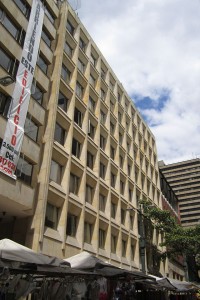 James thinks I need therapy, on account of my affection for Brutalist architecture.
James thinks I need therapy, on account of my affection for Brutalist architecture.
Which got me thinking… why do I like it? It’s not like I am particularly an architectural critic. I’m not even sure it falls under the category of “Having an opinion to have an opinion,” which I sometimes do.
My first thought was comic books, which explains my aesthetic tastes in some things (like solid colors over patterns). That would explain my appreciation of gothic architecture, for example. But if brutalist architecture is common in comic books the same way that gothic architecture often is, I can’t think of any examples.
But I like it for its simplicity, raw utilitarianism. Yet I don’t have the same fondness for the glass boxes that take up skylines (I don’t dislike them, either, but it’s not the same). But my instinct is along the lines of “I like it because that’s how government buildings are supposed to look.” Why do I think that?
I think it’s because of my dad.
My father worked at a sprawling government installation that more or less defines the area of the suburbs where I was raised. I will call it Livingston AFB. And he actually worked on the base, as opposed to across the street where my brother does. Which meant that when I went to see him at work, I would go onto the base with all of its buildings that were… brutalist. Or something indistinguishable to it, to my eye.
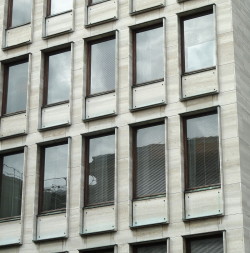 And of course my father was awesome, the government agency he worked for was awesome, and all that jazz. Better yet, it was in the pre-9/11 days when you had a degree of free access to it (I think the sticker on our cars were required), and driving around it was interesting with all of the planes and other aircraft they had on display. And, of course, it was the very symbol of the federal government where I grew up.
And of course my father was awesome, the government agency he worked for was awesome, and all that jazz. Better yet, it was in the pre-9/11 days when you had a degree of free access to it (I think the sticker on our cars were required), and driving around it was interesting with all of the planes and other aircraft they had on display. And, of course, it was the very symbol of the federal government where I grew up.
So other designs that are so-called “nice looking” and a hoity-toity “non-depressing” and “sort of looks oppressive” carry no truck with me.
And of course, once you like something and dislike something, you come up with more reason to like or dislike it. Which is probably where my “honesty in architecture” comes from. And my vague belief that government facilities shouldn’t look nice. They should be there, and tolerable. Like the government! Or something.
Via Dustbury and Autoblog, here is a video of a news reporter who doesn’t know how to use an ice scraper:
She takes the correction in really good humor. And in her defense, she apparently made her way up to Washington State by way of Los Angeles, where you don’t have to deal with this sort of thing often.
I can relate. I remember when I first moved to Deseret from Colosse. It’s not that there was never ice in Colosse that needed to be scraped off, but you never needed more than a credit card and taking anything more than a hand-scraper was a waste of automobile interior real estate. Snow? The last time I had seen snow that was still snow when it hit the ground was 1987.
So it was a bit of a shock.
Also, I had to learn quite a bit about these things. Including the ubiquitous design of those scraper-brushes, and how they worked.
Another thing I learned was that below a certain temperature, even cars that are otherwise in good working order won’t start. I remember my shock when I arrived and people would go into the convenience store while leaving their cars running. Back in Colosse, that was asking to get your car stolen, it seemed to me. But people there did it all the time. Was crime really all that non-existent? Not the case, it turned out. It was just that the comparative risk of a car failing to restart versus the less common but more severe stolen car… well, the frequency of the former trumps the severity of the latter.
What I’ve discovered since, I’ve determined, is that the concern over the stolen car is most likely pretty foolish to begin with. It’s just something you only notice when stopping your car and taking the key out of it takes some risks. This goes into a bit about the regional and generational differences in how we think about crime and the risk of crime. A subject for a post at a later date. Right now we’re talking about ice scrapers.
As it turns out, the scraper-brush is almost a perfectly sized broom for Lain to push around the outside deck when she wants to mimic me pushing around the deck broom. It is every bit as cute as you imagine.
As some of you may recall, I’m kind of a tall guy. I’m not quite as tall as a couple of my friends, who have me by an inch or two, but I’m not used to people being particularly taller than I am. It’s kind of intimidating in its unusualness. People taller than I am are freaks.
Today at the post office, I was in line with a guy who was very, very tall. In between us was a woman who was not short who said that she couldn’t remember the last time she felt so short. She asked the freakishly tall guy how tall he was. 6’11”, it turned out. I was glad that she asked, because I was kind of curious myself. But I wasn’t going to ask. I wanted to comment about how unusual it is to be the short guy. To look up at other guys. And get to make a joke about the weather being up there.
But I didn’t.
I suspect he’s heard those jokes before.
A stranger walked up to me. “You really should have shaved before coming here.”
“What?”
Sigh. “Nevermind. I need the [something something], where is it?”
“I have no idea.”
Sigh. Grunt. Walks away.
It occurred to me later that he thought I was an employee who showed up without grooming himself appropriately, who didn’t know where stuff was, and who was inarticulate about it. I was wearing a “company shirt” (golf shirt with a logo above the pocket)… but not Petco’s.
The army built a fake city:
The US army has built a fake city designed to be used during combat training exercises.
The 300 acre ‘town’ includes a five story embassy, a bank, a school, an underground subway and train station, a mosque, a football stadium, and a helicopter landing zone.
Located in Virginia, the realistic subway station comes complete with subway carriages and the train station has real train carriages.
We have a vacant lot across the street. You can see it the Hit Coffee background and many of the recent header images. It looks like it was a storage facility of sorts for cargo coming off the nearby train tracks.
The layout is above and we’re one of the houses south.
Local fire departments love to use it for drills and such, which is what made the Army’s Fake City remind me of it. At first I found myself worrying why they were over there. But as it kept happening, I figured out what was going on. They even bring in bails of hay to light on fire to I guess simulate the real thing. Other than that, I’ve seen the parking lot used as a staging ground for a parade and as a dump site for mountains of snow.
The lot is supposed to be torn down soon. There’s a sign for the office complex they’re going to be putting there. It seems like a sub-optimal place for an office park because we’re not exactly in the best part of town. We are pretty centrally located, though, and I guess that counts for something.
Angry Protesters Block, Smash Google Bus
In another display of ire directed toward vehicles that haul Google employees to and from work, a smattering of protesters blocked the GBus from moving Friday morning. Said protesters have even allegedly resorted to damaging the buses.
Today’s initial protest began at 24th and Valencia at around 9 a.m. where residents angry at the tech industry blocked the bus and carried signs reading “Get off the bus and join us!” and “Eviction Free San Francisco.” As many of you know, the Bay Area is undergoing a brutal eviction crisis, with San Francisco feeling the brunt of it. Mission District Supervisor David Campos introduced anti-eviction legislation earlier this year, which would provide “incentives against the Ellis Act” to landlords. These google buses — which, in all fairness, do combat the impact the workforce has on local sustainability, as well as the release of CO2 and other emissions — have become a symbol of the gentrification and economic disparity many denizens feel has taken over their city.
As Mission Local reports, the other dustup was “at MacArthur BART station and in West Oakland at 7th and Adeline.” Craig Frost, who was inside the Oakland bus that was physically damaged, tweets, “My Gbus got hit by protesters in Oakland and they broke a window.” While Google software engineer Joel Weinberger (rather adroitly) points out, “I assume all the #googlebus protesters tweeting ‘get out of the Bay, techies’ see the irony of doing so on Twitter?”
When Is a Google Bus Not Just a Google Bus?
Part of what makes the debate about Google buses — as all tech shuttles are collectively known here, no matter whose they are — so fierce is that there seems to be a fundamental disagreement about what’s at stake. Tech employees see the Wi-Fi-equipped shuttles as nothing more than a boring corporate perk — “a thing on wheels that gets us to work,” as one Googler put it at the hearing. As my year-ago ride on a Facebook shuttle confirmed, these aren’t party buses in the least; most tech workers sleep or answer e-mails on a silent hourlong commute to the peninsula. And it’s hard to argue with Google buses on the merits. They reduce emissions, cut down drastically on the number of individual cars being driven in San Francisco, and make the city a more livable place for people who would otherwise be stuck in San Jose. They do produce some first-order consequences that aren’t great (clogged bus stops, frequent delays for public-transport riders) but nothing that couldn’t be ironed out with better data and planning.
Of course, the Google bus wars have never really been about the Google buses.
For concerned locals, the shuttles symbolize their collective fears about the rise of the tech sector — that rents are spiking, that long-time residents are being pushed out by coddled 22-year-olds with Stanford BAs and venture funding, that a great American city with a rich countercultural history is turning into a staid bedroom community for Silicon Valley. It’s hard for people to put these feelings into words, and even harder to get them heard in front of cameras and policymakers. And so, when the MTA board announced a hearing on the bus issue with time set aside for public comments, it was a good bet that the tech resisters would turn it into a catchall venting session.
“This is class warfare! This is not an accident! This is privatization of public spaces!” said one opponent of the bus proposal.
“These buses represent filthy rich corporations that could pay more,” said another.
“We need to squeeze them for everything they’re worth,” said a third.
The underlying force is this: the megacompanies of Silicon Valley — Facebook, Apple, Google, et al. — and their economic ecosystem seem to have grown into an enormous employment engine; analagous to the biggest urban concentrations of factories in the Industrial Age. However, these companies’ campuses are located in the leafy suburban municipalities of the Peninsula, a hour to two hours south of San Francisco.
These municipalities are tightly legislated low-rise, low-density burghs, with residential real estate values that have ascended into the stratosphere as Silicon Valley became more important over the decades. Now, people who’ve paid a million or two million for their 3-bedroom 1960′s tract home are not likely to embrace zoning changes that would allow more housing to be built, as that would greatly dilute the value of their property, as well as changing the kind of suburb they’ve paid so much money to live in.
As a result, these municipalities reap the benefits of having enormous employment centers, and those benefits are then divided among a small number of residents. But the companies themselves have no place to house their workers. Thus, they created the Google Buses, luxury coaches replete with wi-fi and other amenities, deployed to expand the radius in which a Silicon Valley tech worker can practically live.
It’s Not Too Late to Make San Francisco Affordable Again. Here’s How
Protect existing rent-controlled housing units
San Francisco has roughly 172,000 units of rent-controlled housing. Rent control is the city’s core tenant protection, allowing many people to stay here. The first thing the city needs to do is to make sure we don’t lose those units.
As housing prices go up, there is ever more incentive for owners of rental units to find a way to get out of the landlord business and sell. One of the most often abused mechanisms is California’s Ellis Act, a state law that says that landlords have the unconditional right to evict tenants to “go out of business.”
Tenant groups in San Francisco have developed a set of proposals to make it more difficult for landlords to use the Ellis Act as a tool to evict people. One of the proposed reforms that seems to make sense is to discourage the practice of buying rent-controlled units for the purpose of converting to Tenancy-in-common units (TICs) or condos by requiring landlords to have been in the landlord business for some set period of time before using the Ellis Act to “leave the business.”
There is a social compact in San Francisco that needs to be upheld: rent-controlled units should stay under rent control, while ownership opportunities should come from new construction.
Japan Shows the Way to Affordable Megacities
Japanese cities have for centuries taken a much more laissez-faire approach to development than their counterparts in the West. Building regulation in London started in earnest after the Great Fire of 1666, with the city moving away from flammable wood buildings to sturdier stone and brick, and giving authorities the power to widen streets to act as firebreaks. Manhattan was gridded in 1811 and wood-frame construction was banned in 1815. Paris cut wide avenues through its dense, medieval city center under the direction of Baron Haussmann in the mid-19th century. {…}
As a result of lax development rules, Tokyo — whose greater metropolitan area has surpassed 35 million inhabitants, putting to shame piddling two-bit towns like Mexico City, Delhi and Jakarta — is still growing at a rapid clip, despite the fact that Japan as a whole hit its population peak in 2008. (Rural areas and second-tier cities, and even some neighborhoods in first-tier ones, are emptying out as young people flee to large cities for better economic opportunities.)
The number of apartments and houses in the metropolitan-prefecture of Tokyo — whose population is a bit more than 13 million, compared to New York City’s 8.3 million — rose, on average, by 1.95 percent a year between 1998 and 2008, or more than twice as fast as its three world city competitors. (London’s housing stock grew by 0.82 percent annually around the same period, while the number of homes in New York’s five boroughs, as well as Paris and its inner suburbs, inched up just half a percentage point.)
What is Japan’s reward for allowing its largest cities’ housing supplies to keep up with demand? As your economics 101 professor could probably guess, relatively cheap housing.


